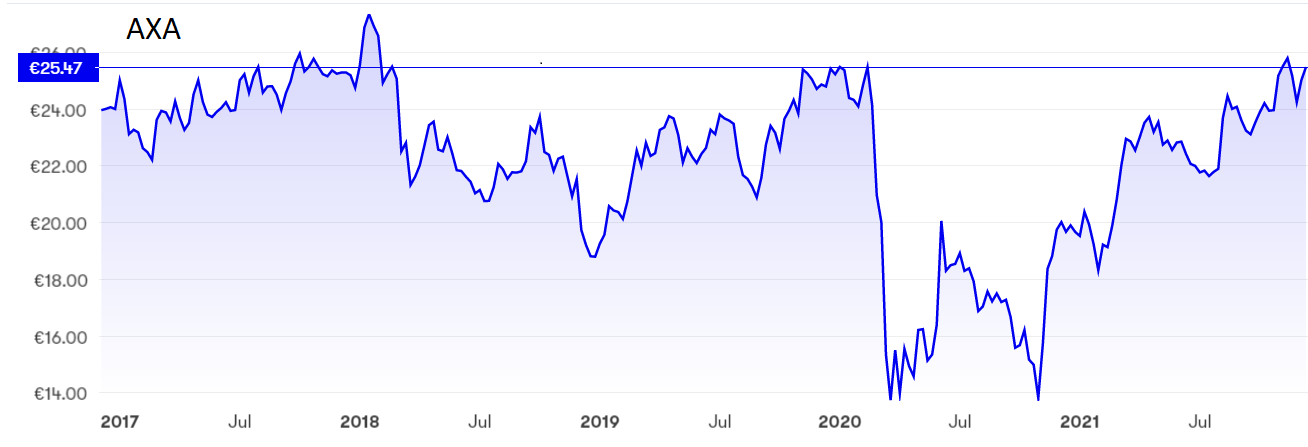Time to buy one of the 10 biggest dividend payers in the world
8th December 2021 08:25
by Rodney Hobson from interactive investor
After a stunning first half, shares of this famous income stock are marking time, but that may be about to change, reckons our overseas investing expert.

Rodney Hobson is an experienced financial writer and commentator who has held senior editorial positions on publications and websites in the UK and Asia, including Business News Editor on The Times and Editor of Shares magazine. He speaks at investment shows, including the London Investor Show, and on cruise ships. His investment books include Shares Made Simple, the best-selling beginner's guide to the stock market. He is qualified as a representative under the Financial Services Act.
French insurance giant AXA SA (EURONEXT:CS) has widened its product range and expanded into North America to enhance its results. These moves have, however, left investors and the shares largely unmoved. The high yield – AXA is one of the 10 biggest dividend payers in the world – could be the temptation that finally breaks the deadlock.
AXA was once seen as a narrow, purely life insurance business largely confined to its home territory with ambitions spreading little further than Europe. It is being transformed into a business covering all forms of insurance plus wealth management and other financial services.
The takeover of XL Group, a leading global property and casualty insurer, in 2018 has offered substantial synergies, and it has encouraged AXA to broaden its geographic horizons to open up another possible route to profitable expansion. AXA is big enough to handle expansion easily but is small enough to have plenty of growth potential – it is after all still only number two in Europe behind Allianz SE (XETRA:ALV).
- The world’s 10 biggest dividend payers in the second quarter of 2021
- Bill Ackman: hot sectors and the economy in 2022
- Want to buy and sell international shares? It’s easy to do. Here’s how
- Friends & Family: ii customers can give up to 5 people a free subscription to ii, for just £5 a month extra. Learn more
Results this year have been encouraging. For the nine months to the end of September gross revenue rose 4% to €73.4 million. The traditional life insurance and savings side is still doing best, with an 8% increase in revenue reflecting the high quality of this part of AXA’s business. AXA’s solvency rating, a measure of how strong its balance sheet is to cope with adverse economic circumstances, has been edging higher this year and now stands at 214% compared with 200% at the start of the year.
The reaction of analysts to the latest results was generally favourable and several raised their share price targets. However, investors are less convinced and the lack of progress in the stock market price has prompted AXA to begin a €1.7 billion share buyback programme designed to run for up to six months.

Source: interactive investor. Past performance is no guide to future performance
Two issues are holding back investors. One is the chopping and changing that raises fears that AXA is not yet properly focused. In recent months it has reorganized its Indian non-life operations in a joint venture and sold its insurance businesses in Singapore and in Malaysia.
The other is that the insurer may run out of steam after a spectacular rebound in the first half, especially if the spike in Covid-related claims that bedevilled results last year is repeated. AXA reported nearly €4 billion in net profit in the first half compared with €1.43 billion in the same period of 2020 when claims arising from business interruption and event cancellation prompted a €1.5 billion charge.
The second half will not prove so spectacular, given that it will include possibly €500 million in claims for July’s floods in Germany and Belgium. There are also some outstanding issues over claims by French restaurant owners forced to shut down last year, but these are gradually being ironed out.
- Why I’m buying ‘value’ stocks and other top tips
- Ian Heslop's outlook for the US stock market in 2022
- Take control of your retirement planning with our award-winning, low-cost Self-Invested Personal Pension (SIPP)
On the whole, first-half figures showing a 12% rise in net income do suggest a particularly robust underlying performance that should be repeated, at least in part. The XL unit, which bore the brunt of the pandemic claims last year, swung back into profit in the first half of this year and chief executive Thomas Buberl is confident that it will achieve its €1.2 billion earnings target for the full year, thanks to increases in premiums.
AXA shares have consistently hit a ceiling at around €25 over the past five years, but they have recovered well from the horrors of last year, when they twice fell below €14. They are now bumping against the ceiling again.
Hobson’s choice: Buy below $27. The shares should make a push towards €29, which could prove to be the next ceiling. The downside looks limited to €24 and there is comfort in the yield of 5.6%.
Rodney Hobson is a freelance contributor and not a direct employee of interactive investor.
These articles are provided for information purposes only. Occasionally, an opinion about whether to buy or sell a specific investment may be provided by third parties. The content is not intended to be a personal recommendation to buy or sell any financial instrument or product, or to adopt any investment strategy as it is not provided based on an assessment of your investing knowledge and experience, your financial situation or your investment objectives. The value of your investments, and the income derived from them, may go down as well as up. You may not get back all the money that you invest. The investments referred to in this article may not be suitable for all investors, and if in doubt, an investor should seek advice from a qualified investment adviser.
Full performance can be found on the company or index summary page on the interactive investor website. Simply click on the company's or index name highlighted in the article.
Disclosure
We use a combination of fundamental and technical analysis in forming our view as to the valuation and prospects of an investment. Where relevant we have set out those particular matters we think are important in the above article, but further detail can be found here.
Please note that our article on this investment should not be considered to be a regular publication.
Details of all recommendations issued by ii during the previous 12-month period can be found here.
ii adheres to a strict code of conduct. Contributors may hold shares or have other interests in companies included in these portfolios, which could create a conflict of interests. Contributors intending to write about any financial instruments in which they have an interest are required to disclose such interest to ii and in the article itself. ii will at all times consider whether such interest impairs the objectivity of the recommendation.
In addition, individuals involved in the production of investment articles are subject to a personal account dealing restriction, which prevents them from placing a transaction in the specified instrument(s) for a period before and for five working days after such publication. This is to avoid personal interests conflicting with the interests of the recipients of those investment articles.